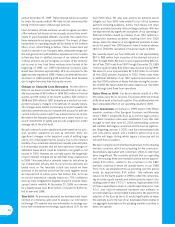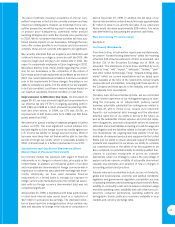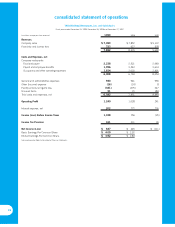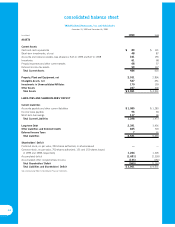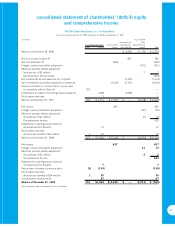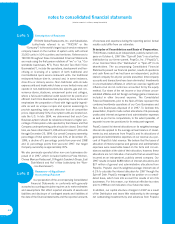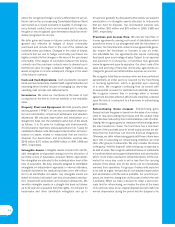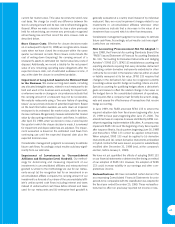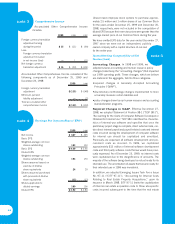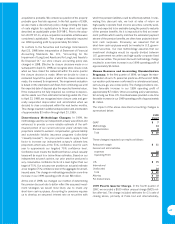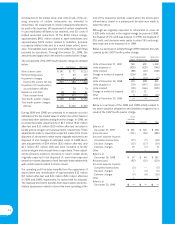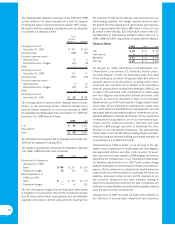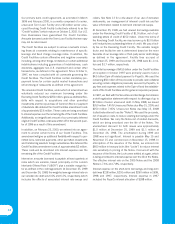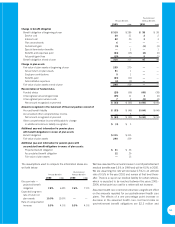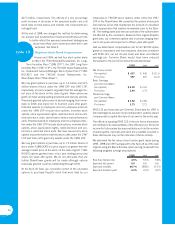Pizza Hut 1999 Annual Report Download - page 48
Download and view the complete annual report
Please find page 48 of the 1999 Pizza Hut annual report below. You can navigate through the pages in the report by either clicking on the pages listed below, or by using the keyword search tool below to find specific information within the annual report.
46
Comprehensive Income
Accumulated Other Comprehensive Income
includes:
1999 1998 1997
Foreign currency translation
adjustment arising
during the period $15 $ (21) $ (90)
Less:
Foreign currency translation
adjustment included
in net income (loss) —1 (11)
Net foreign currency
translation adjustment $15 $ (20) $ (101)
Accumulated Other Comprehensive Income consisted of the
following components as of December 25, 1999 and
December 26, 1998:
1999 1998
Foreign currency translation
adjustment $ (133) $ (148)
Minimum pension
liability adjustment —(2)
Total accumulated other
comprehensive income $ (133) $ (150)
Earnings Per Common Share (“EPS”)
1999 1998
Net income $ 627 $ 445
Basic EPS:
Weighted-average common
shares outstanding 153 153
Basic EPS $ 4.09 $ 2.92
Diluted EPS:
Weighted-average common
shares outstanding 153 153
Shares assumed issued on
exercise of dilutive
share equivalents 24 20
Shares assumed purchased
with proceeds of dilutive
share equivalents (17) (17)
Shares applicable to
diluted earnings 160 156
Diluted EPS $ 3.92 $ 2.84
Unexercised employee stock options to purchase approxi-
mately 2.5 million and 1 million shares of our Common Stock
for the years ended December 25, 1999 and December 26,
1998, respectively, were not included in the computation of
diluted EPS because their exercise prices were greater than the
average market price of our Common Stock during the year.
We have omitted EPS data for the year ended December 27,
1997 since we were not an independent, publicly
owned company with a capital structure of our own
for the entire year.
Items Affecting Comparability of Net
Income (Loss)
Accounting Changes. In 1998 and 1999, we
adopted several accounting and human resource policy
changes (collectively, the “accounting changes”) that impacted
our 1999 operating profit. These changes, which we believe
are material in the aggregate, fall into three categories:
• required changes in Generally Accepted Accounting
Principles (“GAAP”),
• discretionary methodology changes implemented to more
accurately measure certain liabilities and
• policy changes driven by our human resource and accounting
standardization programs.
Required Changes in GAAP. Effective December 27,
1998, we adopted Statement of Position 98-1 (“SOP 98-1”),
“Accounting for the Costs of Computer Software Developed or
Obtained for Internal Use.” SOP 98-1 identifies the character-
istics of internal-use software and specifies that once the
preliminary project stage is complete, direct external costs, cer-
tain direct internal payroll and payroll-related costs and interest
costs incurred during the development of computer software
for internal use should be capitalized and amortized.
Previously, we expensed all software development and pro-
curement costs as incurred. In 1999, we capitalized
approximately $13 million of internal software development
costs and third party software costs that we would have previ-
ously expensed. As of December 25, 1999, no interest costs
were capitalized due to the insignificance of amounts. The
majority of the software being developed is not yet ready for its
intended use. The amortization of assets that became ready for
their intended use in 1999 was immaterial.
In addition, we adopted Emerging Issues Task Force Issue
No. 97-11 (“EITF 97-11”), “Accounting for Internal Costs
Relating to Real Estate Property Acquisitions,” upon its
issuance in March 1998. EITF 97-11 limits the capitalization
of internal real estate acquisition costs to those site-specific
costs incurred subsequent to the time that the real estate
note 4
note 5
note 3


